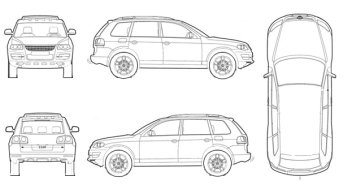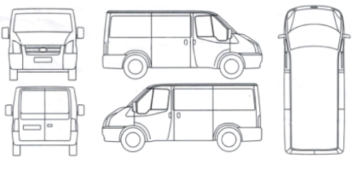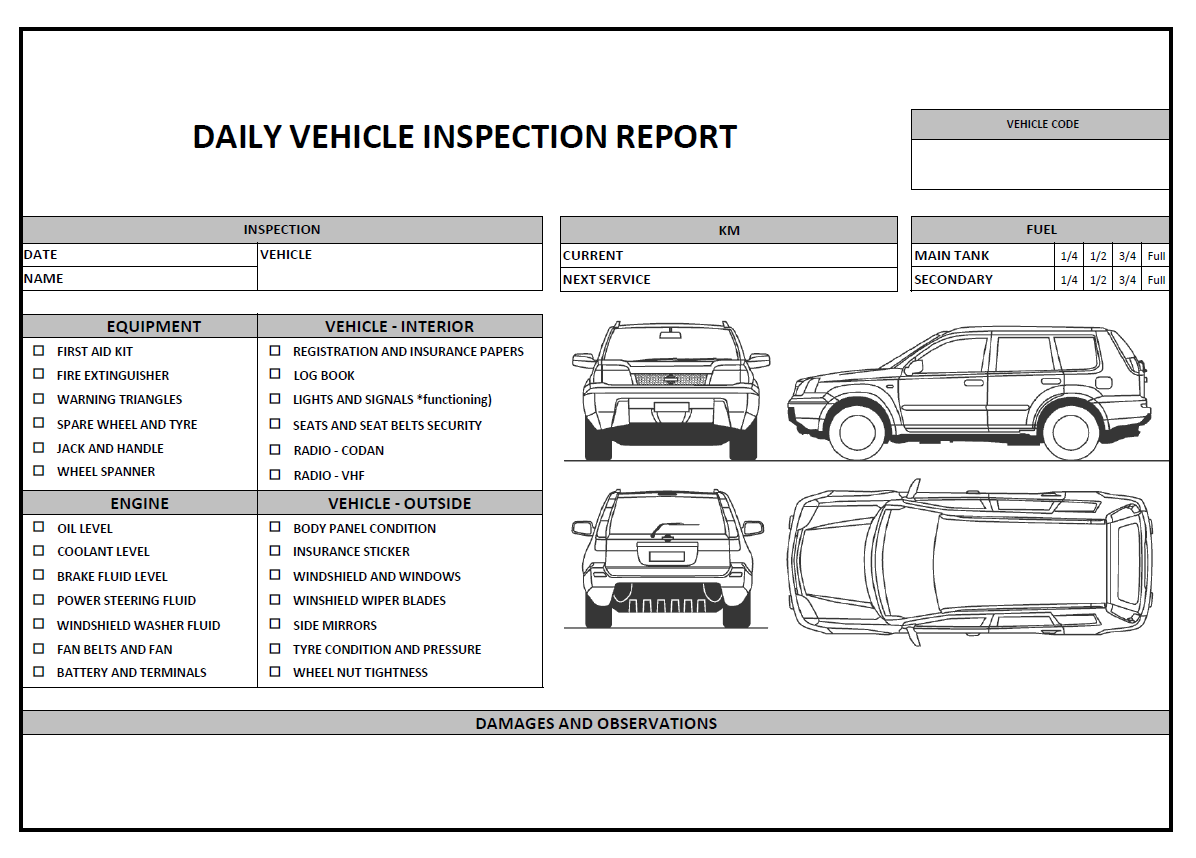Vehicles
The basic considerations in choosing the most suitable passenger vehicle are related with its intended purpose, the number of passengers requiring simultaneous use, and length and frequency of the journeys. Three main options are to be considered at this first stage: motorbike, light vehicle or van/minibus. If transporting cargo, the required cargo capacity should be anticipated. Vehicles with independent trunk or hybrid solutions such as pick-up vehicles can be considered. Visit the road transport chapter for more information on cargo truck selection. The operating context, environmental and road conditions will affect the decision and determine technical requirements of the vehicle such as 4WD, air conditioning, or other extra features. Availability of spare parts in the local market and local knowledge and capacity to achieve all type of maintenance and repairs is also an important factor to consider.
Other factors that can limit the selecting options can be the available budget, donor’s requirements or organisational policies on standardisation of vehicles. Donor regulations can restrict the type or origin of vehicles that they will fund.
Standardisation
Fleet standardisation can be useful when similar functions are to be achieved by the given set of vehicles. Standardising a fleet consists of reducing fleet vehicle diversity, contributing to significant cost savings and gaining efficiency in key processes such as:
- Planning - Costs, assignments, maintenance.
- Vehicle daily operation - Regular checks, use of controls and displays, driving “feel”.
- Maintenance and repairs - Diagnosis, tools, expertise.
- Inventory management - Spare parts, fuel, fluids.
- Procurement and vendor relations - Market research, contracts, invoices.
- Monitoring - Comparing performance among vehicles and drivers, expenditures.
It is important to undertake standardisation not only at vehicle make and model level, but also for vehicle major components and equipment. Purchasing one type of filter, for example, can help track consumption and while enabling fleet managers to negotiate bulk purchases. Improperly managed standardisation can lead to suspicions of collusion: all decisions about standardising the fleet must be done transparently and with high levels of accountability.
Ownership Modalities
When it comes to vehicle selection and acquisition, ownership modality becomes a relevant debate. Vehicles belonging to a self-managed fleet can be owned, rented or leased.
Owned Vehicles:
If an organisation decides to acquire its own vehicles, there are a number of areas to be considered. For more information on the advantages and disadvantages of managing self-owned vehicles, please reference the section on self-owned vehicles in the road transport section of this guide.
Rented Vehicles:
Rented vehicles have become available almost everywhere in the world. Depending on the context, rentals are offered by private companies or individuals, with or without driver. The reasons to use rented vehicles can be various; financial, programmatic, technical or due to insecurity. Some key factors to consider when renting a vehicle might include:
- The duration of the activities is unknown, and recovering the investment of a vehicle purchase may be difficult.
- The cost of importing a vehicle is too high and there are no vehicles of suitable quality in the country of operation.
- There is an urgent need for increasing the fleet and procuring one or several vehicles will take an unreasonable amount of time.
- There is a sudden increase of demand for transport, such as rapid assessment or new activities.
- There is insufficient work for a full-time vehicle.
- The standard type of vehicle is not suitable for the work, the context, or the environmental conditions.
- Insecure environments where risk of damage or theft is so high that economically it is not worth the risk of purchasing a vehicle.
In all cases some considerations and specific actions must be undertaken before and during a vehicle rental:
- A proper inspection of the vehicle.
- Validation and induction of the rental driver.
- Developing a contract for the service provision.
Technical and Administrative Inspection of Rented Vehicles
When renting a vehicle it is important to assess its general mechanical and administrative condition. This is done for several purposes:
- Avoiding delays to programmed activities due to vehicle breakdown.
- Enhancing safety of the people involved in the movement.
- Avoiding being blamed of damages already present in the vehicle.
- Ensuring compliance with all national and local regulations.
Ideally all inspections should be performed by a qualified mechanic. It is recommended to use an inspection template that will allow automatic and homogeneous inspection of all vehicles, enabling a reasonable comparison and validation prior to contracting. It is suggested to keep the separate records for each vehicle inspected. An inspection template could cover the following fields:
- Km reading
- Fuel level
- Engine (Noise, leakage, smoke)
- Lubrication System (Leakage, filters, pressure)
- Cooling System (Leakage, radiator, liquid, fan, belt)
- Air admission & injection (Air filter, fuel filter)
- Exhaust System (fixing, leakage)
- Fuel Tank (leakage, pipes)
- Brake System (leaks, noise, pedal, parking brakes)
- Suspension (soft/hard, springs, shock absorbers-bushes)
- Tyres (pressure, tread, state and spare wheel)
- Chassis (Cracks, fastening)
- Body (impacts, bumpers, bonnet)
- Doors (windows, hinges, adjustment, locks)
- Visibility (windshield, mirrors, sun visors)
- Seats (seat belts, fastening)
- Electrical System (battery, starter motor, front and rear lights, Indicators, roof lights, dashboard warning/indicators, wiping system, horn)
- Availability of Jacks & Tools
- Administrative Documents (Registration, Chassis & Engine Nº, Vehicle insurance)
A guide for users to mark where physical damages might show on the body:
Sedan

SUV

Van

A template for a daily physical inspection might look like:

Adapted from IFRC
It is required to cross-check the vehicle identification (chassis number and engine number) with the administrative documents and the owner identification. Any uncertainty about the ownership or mismatch between the vehicle and the presented documentation should immediately disqualify the vehicle from service.
Validation and Induction of Rental Drivers
Equally important to the mechanical condition of the rental vehicle are the rental driver’s health condition, driving skills, administrative permits, driving and working behaviour and required knowledge to operate the vehicle in the required context, such as speaking local language and the geography that will be travelled. For further information on this matter, refer to the below section on recruitment: selecting and testing drivers.
If rental of vehicles is a long-term strategy, consider keeping a pool of “rental” drivers that can be engage upon request. Validating and instructing batches of several drivers in a single session will reduce the time spent in this important activity.
Rental Agreement
In order to draw up a convenient rental agreement, the following should be considered:
- Define the time-frame of the rental and the time unit used for the rate - hour, day, week, month. If the rental exceeds a single day, it is recommended to agree on a daily rate and charge based on days word. If a monthly rate is used, clarify if calendar month, a period of four weeks or 30 days is covered in the contract.
- Clarify who provides the driver - the humanitarian agency or the owner. If the owner provides the driver, clarify that the drier's cost is included in the rental. In addition, the hours the driver can work must be agreed together with the rate for additional worked hours. If required, the owner should provide a second driver. It is advised that the owner provided drivers come with per diem/accommodation.
- Define the party responsible of providing fuel:
- If the agency provides fuel, make sure that the tank is full prior to its first use.
- If the owner/rental company who provides fuel, ensure that the quantity in the tank is enough to achieve the programmed daily movements, avoiding losing valuable time going to the fuel station.
- Identify the site where the vehicle will be parked at night - the agency’s compound or the owners. Where fuel is provided by the agency, the vehicle should be parked in a compound.
- Ensure that there are no restrictions as to where the vehicle can go in any given country. This is especially important on particularly bad roads or in conflict areas.
- Ensure the owner provides insurance and proof of insurance cover. Are passengers already insured or is additional cover required? A comprehensive insurance coverage preferred. The agency should avoid any liability related to car crashes with rental vehicles. Failure to clarify this can lead to dispute and legal demands between vehicle owners and humanitarian agencies.
- Define who is responsible for breakdowns and regular maintenance. It is strongly recommended that responsibility for recovery and repairs falls under the vehicles owner’s responsibility: avoid the responsibility for maintenance or repairs on vehicles which are not owned, as the initial condition of the vehicle can lead to frequent breakdowns, abusive practices and enormous levels of investment. If possible, agree on getting the owner to provide a replacement vehicle at no extra charge in the event of a breakdown or maintenance, without causing undue delay to programmed activities.
- Conduct a complete inventory of tools/utensils, keep a record of these items, and ensure the vehicle carries at least the minimum required tools in case of flat tire or minor repair.
Adapted from MSF Checklist for vehicle rental
Leasing
In some circumstances leasing could be the most financially advantageous method of renting vehicle for a limited period of time. Vehicle leasing is defined as a long-term rental with certain obligations on the lessor to ensure that the vehicle is properly operating and kept in good condition.
Before deciding to lease a vehicle, the ‘whole-life cost’ should be calculated and compared to other procurement options. If leasing is the cheapest option, whole-life costing can then be used to identify the optimum lease period and supplier.
The things to consider when purchasing, renting, or outsourcing can be summarised in the following table:
| Method | Advantages | Disadvantages |
|---|---|---|
| Local Purchase |
|
|
| Foreign Purchase/Import |
|
|
| Renting Vehicles (using local rental providers) |
|
|
| Outsourcing Transport |
|
|
Adapted from Fleet Forum

